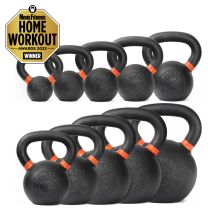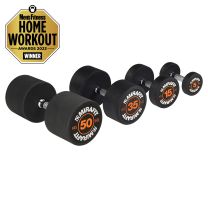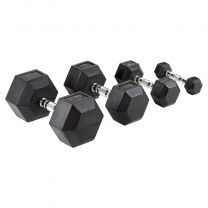6 Best Free Weight Exercises For Upper Body Strength
6 Best Free Weight Exercises For Upper Body Strength

Free weight exercises are some of the best ways to build strength as well as improve your functional fitness levels.
Incredibly versatile, free weight workouts allow you to target specific areas as well as address imbalances. So if you're in a bit of rut thinking you're not getting stronger, it's time to give free weight exercises a go.
However, knowing how to use them is another thing entirely. But if you’re looking to get the most out of your training, then they’re the only way to go.
To help you get started, we’ll go through the basics of free weight workouts as well as some fantastic upper body exercises. And all you need is a weight bench and a pair of dumbbells.
What is free weight training?

The term ‘free weights’ refers to any weights that aren’t machines. So, usually a pair of Dumbbells, as these are one of the most versatile types of free weight.
But they’re basically anything where your movement isn’t guided. This can make them more difficult to use – especially compared to the resistance machines at the gym. However, you can get much more out of them in the long run.
Free weights vs machines

There are lots of benefits to using free weights:
• Full extension - free weights don’t restrict your movements so each exercise can be performed with full muscle extension. This helps to optimise your workouts and improve the quality of your exercises.
• Natural movements - we’re all built differently and the way we move is also different. Machines inevitably influence the way we move. However, free weights allow you to move naturally, which is best for building muscle and avoiding injury.
• Avoid imbalances - free weights not only help you move each side of your body independently, but they also help to highlight any weaknesses. So, as you train, you can be much more focused and avoid asymmetries.
• Work your stabilising muscles - free weights are more demanding, giving you the opportunity to work your stabilising muscles at the same time.
• Versatile - free weights and dumbbells are really versatile. You can use them to target specific areas or several areas the same time. This makes for much more efficient workout.
• Train at home - you don’t need much room to get a solid workout in at home. Get an Adjustable Weight Bench and a set of Hex Dumbbells and you’re all set.
• Perfect for upper body workouts - free weights are especially good for upper body exercises as you can use them to target your shoulders, arms, back and chest. You can also vary the weight load more easily, depending on the exercise.
• Can also be used for lower body - dumbbells are great for doing exercises such as walking lunges, goblet squats, dumbbell hamstring curls and dumbbell deadlifts.
Machines are great for beginners as they help you to get a feel for what sort of movements you need to be doing to work each muscle set. However, anyone looking to build some serious muscle mass will want to use free weights.
What are the best free weight exercises?

1 - Dumbbell hammer curl
How to do them - hold a dumbbell in each hand down by your hips. While maintaining a slight bend in your elbow, bring your arms up and past 90-degrees. Your wrists should be neutral and your thumbs pointing upwards. Release back down to start again.
What muscles they target - biceps, brachialis and brachioradialis
2 - Concentration curl
How to do them - sit on the side of a weight bench with your legs at a 45-degree angle. Hold a dumbbell in your right hand. Push your right upper arm into your right thigh. Curl the dumbbell up with your forearm at a 90-degree angle to your leg. Curl the weight up to your chest and then release back down until your arm is almost straight. Repeat on the other side.
What muscles they target - biceps, brachialis
3 - Dumbbell shoulder press
How to do them - first, put the weight bench in an upright position. Then sit back with a dumbbell in each hand. Bring your arms up ready to push the weights above your head. The dumbbells should be at around ear height with your arms at a 90-degree angle to your body. Push the weights up together until they meet above your head. Then bring them back down. Remember to keep your back straight and your hips pushed back into the bench.
What muscles they target - delts, traps, triceps
4 - Incline dumbbell press
How to do them - place your weight bench at a 45-degree angle. You can raise the seat rest up as well to help you stay in position while you train. With a dumbbell in each hand, sit right back and arch your back. Keep your feet pressed into the floor. Bring your hands into a bench press position. Your elbows should be at a 45-degree angle to your body and the weights around chest height. Push the dumbbells up and towards each other so that they meet above your eyeline. Bring them back down ready to start again.
What muscles they target - pecs, delts, triceps
5 - Lying dumbbell tricep extensions
How to do them - set the weight bench in a flat position and lie back with your feet firmly on the ground. For ease of concentration, do one arm at a time. Holding the dumbbell, stretch your arm back over your head. You can place the other hand on your hip or on the bench down by your side. Keeping your elbow close to your ear, push the weight up so that it meets your eyeline. Then reverse it back down so that it’s behind your head and your tricep is extended. Your hand should be in a neutral position with your thumb pointing downwards. Repeat on the other side.
What muscles they target - triceps, delts
6 - Rear dumbbell fly
How to do them - stand with a slight bend in your knees. Elevate your chest and then come down so that your upper body is almost parallel with the floor. Maintain a straight spine. With a dumbbell in each hand, bring your hands down so that they are directly below your shoulders. Make sure your neck is in line with your spine so that your eyes are looking down at the floor. Squeeze your shoulder blades together. Then, with your palms facing towards each other, lift your arms up as high as they will go. Bring them back down to repeat.
What muscles they target - traps, delts, rhomboids
Can you build muscle with only dumbbells?

Building muscle and strength both require specific styles of training. However, you can of course build muscle with dumbbells, as long as you are lifting enough for your current strength and ability.
In short, to build muscle you need to be failing at around 8-12 reps. Fewer reps than this – around 1-6 reps – will focus your strength. And more reps than this – 15-30 reps – will focus your endurance.
And all of these rely on failing at the top end of those rep counts. Stopping at 12 reps and failing at 12 reps are two different things.
How much weight should a beginner lift?

If you are just starting out, then using a pair of light dumbbells is best so that you can get used to the movements. Once you have a feel for what you should be doing, you can build from there.
Rather than just seeing how much you can pick up, you should let the reps dictate your weight load. If your goal is strength, you should be able to use your chosen weight for up to six reps. If your goal is to build muscle, you should be able to use your chosen weight for up to 12 reps.
And as mentioned above, you should be failing at these points. This is when you can’t physically do any more reps.
If you can’t reach your chosen amount of reps, or you can easily do more, adjust the weight load accordingly.
And remember, you will progress a lot at the beginning of your training. So, make sure that you are always pushing your weight loads up.
Check out our Complete guide to dumbbells
For more content, follow us on Instagram, YouTube, TikTok, and on our official Mirafit Facebook page.
Enter your email to signup to our newsletter







